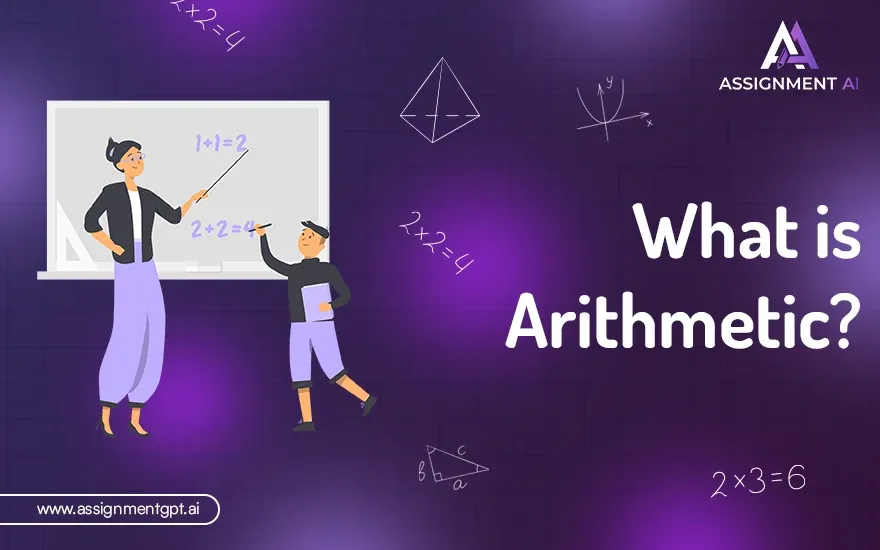AssignmentGPT Blogs
Math sounds boring, right? Nah, not anymore! Math is hard – we’ve all said it, and numbers can be tricky, but what if I told you they're actually pretty cool and easy when you know their secret moves?
As we all know, arithmetic is literally everywhere. From buying and sharing pizza with friends to figuring out discounts when shopping, arithmetic is everywhere. But most of us are unaware of how much we are dependent on it.
The question that arises is what is Arithmetic? Arithmetic isn’t just about passing a math exam, it's about using it in daily life.
Quick Summary
This blog will concentrate on arithmetic along with arithmetic operations like addition, subtraction, multiplication, and division. These math operations are important for everyday calculations. And understanding their properties makes math problems easier. Keep reading to see how these arithmetic functions work and why they’re important!
What is Arithmetic?
Arithmetic is the area of mathematics that is concerned with numbers and manipulation. It consists of mathematical operations. Those operations include adding, subtracting, multiplying, and dividing. It’s the core of math that makes it essential for everything. Be it simple tasks or advanced calculations.
Arithmetic's Real-World Meaning
Arithmetic isn’t just about textbooks or exams—it’s life in action. Ever calculated your monthly expenses? That’s arithmetic functions at work. Think of arithmetic as the universal language of numbers. It's how we:
- Calculate grocery bills
- Manage personal finances
- Plan projects
- Setting budget
- Playing games
Arithmetic Operations
Have a look at the four arithmetic operations and how they work:
| Operation | Symbol | Verb | Definition | Example | Result Vocabulary |
|---|---|---|---|---|---|
| Addition | + | Add | Combining two or more numbers. | 3 + 5 = 8 | The result of addition is a Sum |
| Subtraction | - | Subtract | Taking one number away from another. | 10 − 6 = 4 | The result of subtraction is a Difference |
| Multiplication | x | Multiply | Repeated addition of a number. | 4 × 3 = 12 | The result of multiplication is the Product |
| Division | ÷ | Divide | Splitting a number into equal parts. | 12 ÷ 4 = 3 | The result of division is Quotient |
1. Addition (+)
Addition means combining two or more numbers to get the total sum. This method is essential in everyday math. It’s the basic step of counting and basic math.
- Example: If a child has 3 balls for playing and his friends gave him 5 more. Now he has 3 + 5 = 8 balls.
2. Subtraction (-)
Subtraction is the process of extracting a number to ensure the difference. It’s like an undoing addition.
- Example: If you have $10 as savings and you spend $6. Then, you have left 10 − 6 = $4 as savings.
3. Multiplication (×)
Multiplication means adding the same number multiple times to simplify repeated addition. It makes calculation quicker and easier.
- Example: If one pen costs $3 and you bought 4 pens. Then, the total cost is 3 × 4 = $12.
4. Division (÷)
Division refers to splitting a number into equal parts or groups. It’s the reverse of multiplication.
- Example: If you share 12 candies equally among 4 friends. Then, each friend gets 12 ÷ 4 = 3 candies.
Arithmetic Operators
Arithmetic operators are symbols used to perform math operations. The table below is a quick overview:
| Operator | Name | Usage | Example |
|---|---|---|---|
| + | Addition | It combines numbers. | 7 + 3 = 10 |
| − | Subtraction | It finds the difference. | 9 − 5 = 4 |
| × or * | Multiplication | Multiplies numbers. | 6 × 2 = 12 |
| ÷ or / | Division | Divides one number by another. | 8 ÷ 2 = 4 |
Properties of Arithmetic
Arithmetic properties include the commutative (a + b = b + a, a × b = b × a), associative ((a + b) + c = a + (b + c)), distributive (a × (b + c) = a × b + a × c), identity (a + 0 = a), and inverse (a + -a = 0).
1. Commutative Property
For addition and multiplication, switching the order doesn’t affect the final output.
Example: 2 + 3 or 3 + 2 and 4 × 5 or 5 × 4, the outcome remains the same.
2. Associative Property
Grouping numbers differently doesn’t affect the result in addition and multiplication.
Example: (1 + 2) + 3 or 1 + (2 + 3) the result will be same.
3. Distributive Property
Multiplication distributed across addition or subtraction.
Example: 2 × (3 + 4) or (2 × 3) + (2 × 4) the result will be same.
What is Arithmetic Sequence?
An arithmetic sequence is a set of numbers. That number includes the difference between consecutive terms and is always constant. This constant difference is called common difference. It’s a simple pattern used in many math problems.
Examples of sequences are below:
- Sequence is 2, 4, 6, 8, 10
The difference is +2 and next term would be 12.
- Sequence is 10, 7, 4, 1, -2
The difference is -3 and next term would be -5.
- Sequence is 3, 6, 12, 24, 48
The difference is x2 and next term would be 96.
- Sequence is 1, 1/2, 1/4, 1/8, 1/16
The difference is ÷2 and next term would be 1/32.
Examples with solutions
Q-1. Add 45 and 75 and multiply the result by 3.
Solution: Add 45 and 75: Therefore, 45 + 75 = 120 Now, multiply the sum by 3: The result is120 × 3 = 360
Q-2. Subtract 35 from 55 and divide the result by 2.
Solution: Subtract 35 from 55: Therefore, difference is 55 − 35 = 20 Now, divide the difference by 2: The result is 20 ÷ 2 = 10
Q-3. Solve: (8 × 3) + 15 − 10 ÷ 2.
Solution: Apply the BODMAS rule: Step 1: Multiply- 8 × 3 = 24 Step 2: Divide- 10 ÷ 2 = 5 Step 3: Add- 24 + 15 = 39 Step 4: Subtract- 39 − 5 = 34
Q-4. If you have five boxes with 7 mangoes each, how many mangoes are there in total?
Solution: Each box has 7 mangoes, and there are 5 boxes. So: Total mangoes= 7 × 5 = 35
Q-5. Find the value of 50 − (25 ÷ 5) + (10 × 2).
Solution: Apply the BODMAS rule: Step 1: Divide- 25 ÷ 5 = 5 Step 2: Multiply- 10 × 2 = 20 Step 3- Solve inside the brackets: 50 − 5 = 45 Step 4- Add: 45 + 20 = 65
These examples present what arithmetic operations involving addition, subtraction, multiplication and division do to work together through real-life situations!
Conclusion
Arithmetic is the root of all mathematics. Even if it’s basic arithmetic operations like addition and subtraction or advanced sequences. It’s the starting point for solving everyday problems. Understanding arithmetic and its properties makes calculations faster and easier. Arithmetic is not just about math class. It’s a life skill that helps in budgeting, cooking and decision-making. For instant solutions and extra help, tools like AssignmentGPT’s AI Math Solver make learning math simple and effective.
FAQs
1. What does arithmetic mean?
2. Are arithmetic operations difficult to learn?
3. Why are mathematical operations important?
4. How can someone improve their arithmetic skills?
Content writer at @AssignmentGPT
Kandarp’s world is powered by conversations, content, and creativity. With experience across branding, literature, publishing, and strategy, he has helped shape identities and stories for businesses across industries. At AssignmentGPT AI, he leads a team that blends sharp content, strong design, and local insight to turn businesses into brands that connect with people.
Master AI with
AssignmentGPT!
Get exclusive access to insider AI stories, tips and tricks. Sign up to the newsletter and be in the know!

Transform Your Studies with the Power of AssignmentGPT
Empower your academic pursuits with tools to enhance your learning speed and optimize your productivity, enabling you to excel in your studies with greater ease.
Start Your Free Trial ➤Start your success story with Assignment GPT! 🌟 Let's soar! 🚀
Step into the future of writing with our AI-powered platform. Start your free trial today and revolutionize your productivity, saving over 20 hours weekly.
Try For FREE ➤








